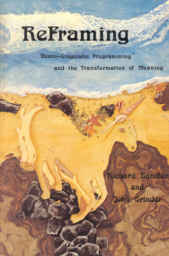As this book is a transcript of a Bandler and Grinder seminar on reframing, similar to one that I
attended around the same time as this one, I recall my reactions to the seminar and some of the things I
learned from it.
The first thing I learned about reframing was to identify the "good intention" of my unwanted
behavior. One can say this is a prerequisite for doing reframing. But is it true? Does every behavior have a
good intention, even those nasty behaviors that we don't like in ourselves? The answer is simply: it doesn't
matter if it's true, but it's very useful to pretend that it's true that every behavior has a good intention. And
when one deals with models, one asks, "Is it useful?" not "Is it true?" Yes, it is very useful to hold the
pretense that every behavior has a good intention. It's useful because if you pretend that it's true, you can
find a good intention and discover that the good intention can be satisfied by other behaviors! Then the
objectionable behavior can be replaced by a behavior that doesn't have the unwanted side-effects of the
original behavior. In a nutshell, that is reframing.
Now let's take a look at how Bandler and Grinder turned this insight into a useful therapeutic tool
and a seminar back in 1977. The first example they give is one that I recall vividly from my seminar with
them. It was a woman who was a compulsive housewife, who, whenever she saw a speck on her carpet or
God Forbid! a footprint, she would feel bad immediately, and she could not feel good until she vacuumed
every trace of the dirt or marks from the carpet. Leslie was Bandler's wife at the time and had learned a few
things about reframing. Here's her intervention with the housewife:
[page 6] What Leslie did with this woman is this: she said "I want you to close your
eyes and see your carpet, and see that there is not a single footprint on it anywhere. It's
clean and fluffy - not a mark anywhere." This woman closed her eyes, and she was in
seventh heaven, just smiling away. Then Leslie said, "And you realize that that means
you are totally alone, and that the people you care for and love are nowhere around." The
woman's expression shifted radically, and she felt terrible! Then Leslie said, "Now, put
a few footprints there and look at those footprints and know that the people you care
most about in the world are nearby." And then, of course, she felt good again.
When I lived in Massachusetts we had a poster on the wall of our only bathroom on the ground floor
where our kitchen and bedroom were, so I went in and out of that door several times a day. The poster said,
"It is only with the heart that one can see rightly what is essential is invisible to the eyes." It was credited
to The Little Prince by Antoine de Saint Exupéry. Later I discovered that it is a very famous quote and it was
told to the little prince by the fox, so it is known as the Fox's Secret. The Fox's Secret meant that the meaning
of things is what is essential and the meaning of things is invisible to the eye. What happens during reframing
is that one is led to understand or hold a new meaning of something in one's world. And with that new
meaning, one is able to interact with the world in a more useful fashion than before.
Did the woman's behavior have a good intention? Yes, it kept her floors clean. Did it have unwanted
side-effects? Yes, it made her a sheer terror to be around in the house, if you stepped in the wrong place, like
on the carpet. When she came to see that the minor marks on the carpet as a sign that her loved ones were
around, the very same marks became a source of good feelings to her, and she moved into being a normal
housekeeper instead of a compulsive one.
The seminar I went to was full of examples of incredible interventions that seem magic to me, but
none seemed so magical as the ones they did right there in the seminar. They'd bring up someone from the
audience who volunteered, do an intervention, and Bingo! every time they were fixed. In the book the
authors talk about how they did the process.
[page 16] An important part of being successful in NLP is knowing what kind of
problem your procedure works on. If you know that, you can do successful
demonstrations any time you want to. You just ask for volunteers who have exactly
what your procedure works on.
I was in a therapy group once with a man who did a brilliant piece of work. His problems were
rampant as he described them to us before he began the session: his bank accounts were overdrawn, his wife
and children had deserted him, he had been fired a couple of days before, his car was stolen, and naturally
he wasn't feeling too well. After his therapy work, he felt great! He was raring to go tackle the world.
Suddenly he grew pensive and said, "You know, I just realized that all my problems still exist out there: my
bank accounts are still overdrawn, my wife, kids, job, and car are still gone. But I feel like I can tackle them
for the first time!" His outward look during the course of the session had completely changed. At the
beginning he was pale and all tight. At the end he glowed with a ruddy complexion and was all relaxed.
What happened to him physiologically?
[page 22 - 23] There are two parts to the autonomic nervous system: the sympathetic
and parasympathetic nervous systems. The two tend to balance each other through
opposite effects.
Sympathetic activation results in increased muscle tension and a readiness to respond
physically to some threat. There is more adrenalin, and the skin whitens as the blood
vessels and pupils constrict. Parasympathetic activation results in muscle relaxation,
flushing of the skin, dilation of the blood vessels, dilation of the pupils, etc. . . . What
we have been describing is that people tend to have sympathetic activation when
presenting a complaint and considering the reframe. Then they shift to
parasympathetic activation when the reframe works, which is what you would expect
to occur. If the reframing works, what was perceived as a problem to cope with
becomes not a problem at all.
What about confusion, isn't confusion a problem? We've been carefully taught that to be confused
is bad and that success is good. Listen to how Bandler and Grinder turn that teaching upside down to get
some parasympathetic activation going on those in the seminar.
[page 33] In our workshops we're always telling you that success is the most dangerous
human experience, because it keeps you from noticing other things and learning other
ways of doing things. That also means that any time you fail, there's an unprecedented
opportunity for you to learn something that you wouldn't otherwise notice. Confusion
is the doorway to reorganizing your perceptions and learning something new. If you
were never confused, that would mean that everything that happened to you fit your
expectations, your model of the world, perfectly. Life would simply be one boring,
repetitive experience after another.
Contrary to popular belief, most people do get what they want out of life, but what they want is just
not worth having. They want a home, a family, a good job, and they get all that and feel empty. But just add
into that bland mixture a couple of adolescent teenagers and suddenly one has one's hands full and every
day brings a new set of challenges. One of the biggest problems with the empty nest syndrome is that when
the children leave, they take their problems with them, leaving the parents with a boring life once more. A
good measure of confusion is essential to add spice to life, rightly understood.
This review gives you just a glimpse of the masters at work. One needs to read the entire book, to
practice the exercises, to do reframing with oneself and others to full comprehend the power of the
techniques described within.
---------------------------- Reference Links for Bandler and Grinder ---------------
Reference Links to Material on Bandler and Grinder
written by Bobby Matherne
http://www.doyletics.com/arj/bnglinks.htm
~^~
Any questions about this review, Contact: Bobby Matherne
~~~~~~~~~~~~~~~~~~~~~~~~~~~~~~~~~~~~~~~~~~~~~~~~~~~~~~~~~~

 == == == == == == == == == == == == == == == ==
== == == == == == == == == == == == == == == ==
22+ Million Good Readers have Liked Us
22,454,155
as of November 7, 2019
Mo-to-Date Daily Ave 5,528
Readers
For Monthly DIGESTWORLD Email Reminder:
Subscribe! You'll Like Us, Too!
== == == == == == == == == == == == == == == ==
Click Left Photo for List of All ARJ2 Reviews Click Right Bookcover for Next Review in List
Did you Enjoy this Webpage?
Subscribe to the Good Mountain Press Digest: Click Here!


CLICK ON FLAGS TO OPEN OUR FIRST-AID KIT.
All the tools you need for a simple Speed Trace IN ONE PLACE. Do you feel like you're swimming against a strong current in your life? Are you fearful? Are you seeing red? Very angry? Anxious? Feel down or upset by everyday occurrences? Plagued by chronic discomforts like migraine headaches? Have seasickness on cruises? Have butterflies when you get up to speak? Learn to use this simple 21st Century memory technique. Remove these unwanted physical body states, and even more, without surgery, drugs, or psychotherapy, and best of all: without charge to you.
Simply CLICK AND OPEN the
FIRST-AID KIT.

Counselor? Visit the Counselor's Corner for Suggestions on Incorporating Doyletics in Your Work.

All material on this webpage Copyright 2019 by Bobby Matherne





